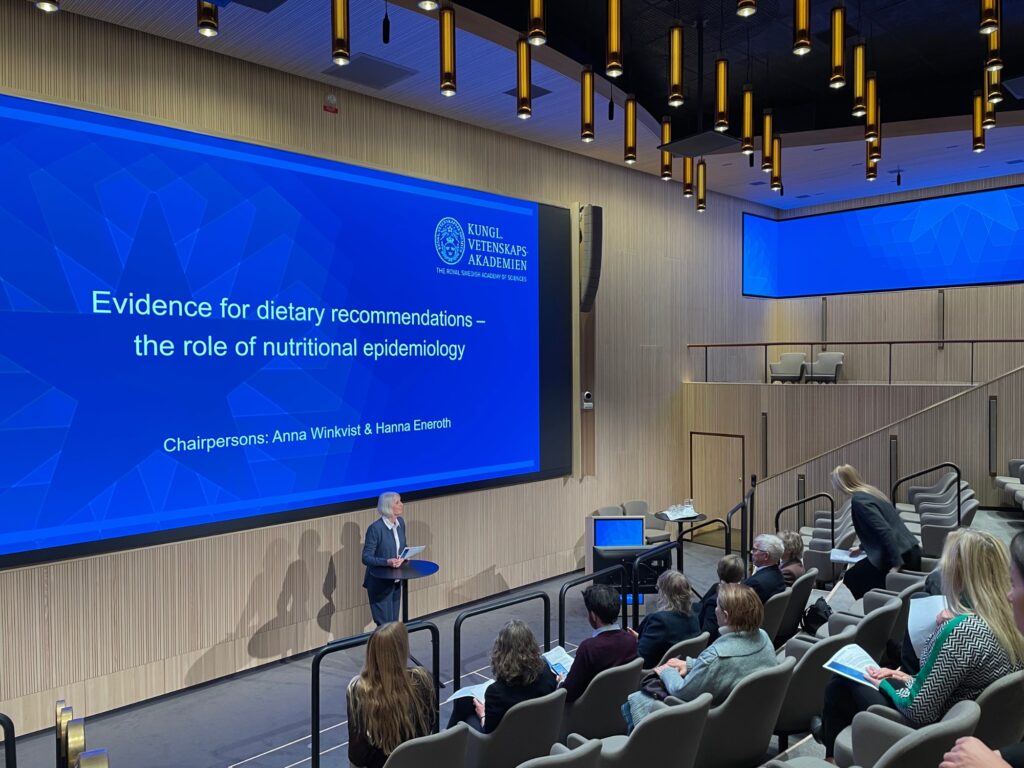On 14 November 2023, seven speakers were invited to a symposium to discuss the science behind the Nordic Nutrition Recommendations 2023 which were released in June 2023. The event was organised by the Swedish National Committee for Nutrition and Food Sciences at the Royal Swedish Academy of Sciences, and the Swedish Food Agency. What is the role of nutritional epidemiology behind the recommendations, and how do we best translate them to policy?
The newly released 6th edition of the Nordic Nutrition Recommendations 2023 (NNR2023) has been developed with several hundred researchers and experts over five years. The guidelines do not only include updated and new nutritional values of different nutrients, but also presents their environmental impact. This makes the NNR2023 the most comprehensive nutritional guideline in the Nordic to date.
The role of nutritional epidemiology behind the guidelines
The process leading up to the NNR2023 was robust with a “cutting edge” methodology, emphasised by Rune Blomhoff from the Department of Nutrition at University of Oslo, and Head of the NNR2023 Committee. The process involved a novel fundament for the assessment of causality through qualified systematic reviews, a transparent documentation of every step, extensive “checks and balances”, as well as a new way of integrating environmental aspects of food consumption – in most of the nutritional values presented, both the health and environmental impacts were taken into account. Yet for some values, such as the recommended consumption of red meat, are only based on health considerations. Despite the robust methodology, Agneta Åkesson from the Institute of Environmental Medicine at Karolinska Institutet and Head of the Systematic Review Centre of NNR2023, mentioned the need to incorporate ongoing method development in nutritional epidemiology also in the future.
Bridging the gap between research and policy
Julie A Lovegrove, Director of the Hugh Sinclair Unit of Human Nutrition; Deputy Director for the Institute for Cardiovascular and Metabolic Research, University of Reading, UK and Deputy Chair, UK Scientific Advisory Committee on Nutrition (SACN), presented her experience of scientific evidence in nutrition research from her work in the United Kingdom. She emphasized the difference between risk assessment (which is often science-based), risk management (which is policy-based) and risk communication (relating to how the science and policy is communicated externally). Researchers and experts can develop research and science-based data, but moving into the policy sphere of risk management takes time. This is a complex process influenced by many things, such as the political and economic context, as well as current crises. The political environment during the Covid-19 pandemic, for example, eased the use of science-based knowledge in policymaking. Xavier Garcia, Director for Epidemiology at RTI Health Solutions in Spain, agreed that “science thrives under challenging times”, leading to new innovations and quicker policy implementation.
Guidelines to a general population
Even though science evidence, such as the NNR2023 were to be picked up in policy, challenges remain on how to apply recommendations across a population in an equitable way. Eva Warensjö Lemming from the Department of Food Studies, Nutrition and Dietetics at Uppsala University, and member of NNR2023 Committee, presented that diets are complex, and so is every individual. Eva stressed that the NNR2023 are guidelines for the whole population, and not specific groups. Still, this raises the question of the difficulty of translating dietary recommendations to diverse populations with varying cultural and socioeconomic contexts and how to balance between providing specific guidelines and acknowledging the individuality of dietary needs.
Some of these concerns were addressed in the symposium. Inge Tetens from the Department of Nutrition, Exercise and Sports, University of Copenhagen, and member of NNR2012 Committee, presented an operationalisation of how a sustainable diet can be divided into four dimensions:
- Health & nutrition: “Nutritionally adequate, safe and healthy”.
- Environment: “Protective and respectful of biodiversity and ecosystems”.
- Culture: “Culturally accepted”.
- Economy: “Accessible, economically fair and affordable”.
Apart from this, people must be able to relate to the guideline in their daily lives and apply them to their diets.
The future ahead
The NNR2023 has caused more reactions than any of its preceding editions. Annica Sohlström, Director General at the Swedish Food Agency, ended the symposium by reflecting upon this. Perhaps the actuality of food systems today, along with the profitability of the food sector, could be two explanations. Nevertheless, the reactions and actuality of the NNR2023 show the importance of nutritional epidemiology research and strengthening our knowledge in this field. Now, Nordic policymakers have the responsibility to use these recommendations to benefit both humans and the planet, Annika said.
